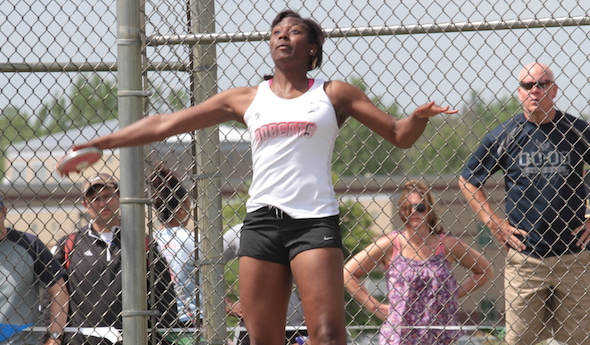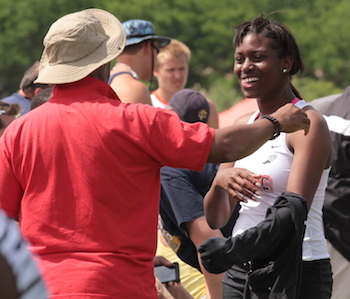
Talent Plus Form Equal Wheeler's Stardom
By
Paul Costanzo
Special for MHSAA.com
March 16, 2017
It was cold and rainy on April 29, 2016, and Grand Blanc’s Quiara Wheeler was scared.
 The line to make to even have your throw measured in the discus at the Charlie Janke Track & Field Invitational in Jackson was 80 feet, farther than her personal best.
The line to make to even have your throw measured in the discus at the Charlie Janke Track & Field Invitational in Jackson was 80 feet, farther than her personal best.
“I was really nervous, because I couldn’t throw very far,” she said. “I threw an 88-4 and was really excited. The week after that I started throwing farther in practice. (Grand Blanc throwing coach Garner Pleasant) and I figured out I was holding it wrong the whole season, then I figured out the hand placement and my footwork.”
After that, she took off.
Wheeler went from scared to be short of the minimum measurement to MHSAA champion in a little more than 30 days, throwing 136 feet, 2 inches on June 4 to win the Lower Peninsula Division 1 title.
“Sometimes they will get a big improvement in the disc because all of the sudden it just clicks,” Grand Blanc girls track & field coach Andy Taylor said. “But it usually takes at least a year or more to do that. To improve 50 feet from the end of April to the state meet, I’ve never heard of that.”
Wheeler improving her personal best by more than 60 feet in one season, and her quick ascension to the top of the state’s pecking order in the discus are actually easier to explain than you would guess.
It was a simple formula: extraordinary talent meets proper form – or close to it, anyway.
“What God has put in her, I can’t put in her,” Pleasant said. “She’s an athlete.”
Wheeler doesn’t just throw for the Bobcats, she also long jumps, with a personal best of 16 feet, and has been on the sprint relays.
She holds a third-degree black belt in martial arts, and her coaches feel that background has helped her to quickly pick things up on the track.
“She’s used to putting in the work and having discipline,” Taylor said. “At the state meet, as she was throwing, I happened to look right in her eyes, and you could tell that she was totally focused.”
While her improvement was lightning fast, it was also gradual, and not without some bumps in the road. In early May, her throws crept into the low 100s – 100-4, 102-1, 113-11 – from May 3 to 10.
Before the Kensington Lakes Activities Association meet, Pleasant decided to add a full spin to Wheeler’s arsenal. She faulted three times, however, and did not record a throw.
“I told her, ‘Forget about it, put it behind you,’” Pleasant said. “When we get ready for the Regional, we’re going to do the South African (technique). At the Regional, she throws the discus 120 feet with a legal South African, and that had to go about 150 feet straight in the air and dropped.
“We had two weeks before the state meet, so all we did is work on the full rotation. That’s all we did for two full weeks.”
 The new technique helped Wheeler reach 132 feet in the preliminary rounds of the Division 1 meet, easily putting her into the Finals.
The new technique helped Wheeler reach 132 feet in the preliminary rounds of the Division 1 meet, easily putting her into the Finals.
Still, the newcomer to the big stage felt the nerves.
“When it came to the Finals, I was by myself and I was trying to calm myself down the whole time,” Wheeler said. “It was kind of overwhelming at first because all of the girls were so good and I was like, ‘How did I make it to the Finals?’”
Wheeler won by five feet, with no one else topping even her preliminary throw.
Her rapid rise caught the eyes of college coaches, and she said she has scholarship offers from Western Michigan University and Heidelberg University in Ohio. Taylor said college coaches are excited about how much more she can grow.
“I actually never really thought about (throwing in college),” she said. “This was before I was good. When the season was going on, I realized maybe I can do this. But I definitely want to continue this in college.”
Pleasant and Taylor both feel Wheeler is only beginning to tap into her potential as a thrower. She’s dedicated her offseason to getting better in the discus, which doesn’t bode well for those trying to catch her.
“I’ve just been training every day, pretty much since October – I also trained in the summer,” she said. “I’ve been lifting weights, and I’m definitely stronger than I was last year. I work out with two other boys, and they push me because they’re stronger than me. I go in and watch videos, footage of me sometimes and how bad my form was. Coming into the season, I’m hoping to be more consistent with my throws.”
Wheeler doesn’t seem worried that she’ll now have a target on her back as the returning Finals champion. In fact, she’s excited to beat her previous achievements, which is what drew her to track in the first place.
Pleasant has her aiming for the stars.
“I told her, ‘You should be setting your sights on the best marks in the state,’” Pleasant said. “That’s what we’re shooting for, having the best marks in the state. It’s not about state, it’s about going out and trying to have some of the best marks in the nation if you can.”
 Paul Costanzo served as a sportswriter at The Port Huron Times Herald from 2006-15, including three years as lead sportswriter, and prior to that as sports editor at the Hillsdale Daily News from 2005-06. He can be reached at [email protected] with story ideas for Genesee, Lapeer, St. Clair, Sanilac, Huron, Tuscola, Saginaw, Bay, Arenac, Midland and Gladwin counties.
Paul Costanzo served as a sportswriter at The Port Huron Times Herald from 2006-15, including three years as lead sportswriter, and prior to that as sports editor at the Hillsdale Daily News from 2005-06. He can be reached at [email protected] with story ideas for Genesee, Lapeer, St. Clair, Sanilac, Huron, Tuscola, Saginaw, Bay, Arenac, Midland and Gladwin counties.
PHOTOS: (Top) Grand Blanc’s Quiara Wheeler tosses the discus during last season’s Lower Peninsula Division 1 Finals. (Middle) Wheeler enjoys a moment away from the throwing circle. (Photos by John Brabbs/RunMichigan.com.)

Hastings Relays Reigns as State's Oldest Continuous Track & Field Meet
By
Steve Vedder
Special for MHSAA.com
April 10, 2024
Bob Branch remembers dabbling in other sports, but his first love was always running.
 The Hastings High School graduate admits he could never hit a baseball, football didn't especially appeal to him and basketball was just another way to spend time with friends. But for Branch, now 93, there was always track. That's the sport where his fondest and sharpest memories remain. And if you're talking track, many of his favorite memories come from participation in the state's oldest continuous track meet, the Hastings Relays.
The Hastings High School graduate admits he could never hit a baseball, football didn't especially appeal to him and basketball was just another way to spend time with friends. But for Branch, now 93, there was always track. That's the sport where his fondest and sharpest memories remain. And if you're talking track, many of his favorite memories come from participation in the state's oldest continuous track meet, the Hastings Relays.
Always held in early April, the meet dates back to 1937 – a bygone time that saw the first hostilities of World War II, gas at 20 cents a gallon and a loaf of bread selling for a dime.
And at a dusty old track surrounding the county fairgrounds in Hastings, a small relay event that included a scattering of participants from a dozen high schools was taking its first tentative steps.
Branch recalls a time when kids would run home after track practice because there were no buses, inexperienced young coaches had little actual knowledge of running fundamentals, and athletes looked at the sport as an afterthought after spending most of their high school days playing football and basketball.
 For Branch, the relays were the ideal way to ease into the track season.
For Branch, the relays were the ideal way to ease into the track season.
"I just liked to run," said Branch. "I remember I anchored a relay with my brother, and it always seemed cold when we had that meet. I remember teams would come from all over and you saw a lot of good athletes. Everybody seemed to have someone who was really good. Track wasn't very popular at that time, but I have a lot of good memories from running."
The Hastings Relays, which has changed formats and even names during its nearly nine-decade history, would traditionally kick off the track season. The meet was originally held at a makeshift quarter-mile track which surrounded the town's fairgrounds and was part of the city's annual Hastings Carnival – the track would become the midway during fair time.
The meet eventually moved to Johnson Field when the football field was dedicated in 1949 and ballooned to as many as 50 teams at its peak in 1957. For more than seven decades it was known as the Hastings Relays and then the Hastings Co-Ed relays before becoming the current Hastings Invitational, with the latest edition scheduled for Friday.
Johnson Field had a cinder track before it became an all-weather surface in the 1980s. During a time long before computers would be used to organize meet heats in mere minutes, Hastings coaches of all sports – defined as "volunteers" by the athletic department – would meet on the Friday before competition to hash out events.
People associated with the meet still recall the camaraderie built on those long Friday nights, followed by working what would often become 10-hour meets. Steve Hoke has been involved since watching his father, Jack, who coached teams at 15 of the meets beginning in 1951 and also had run in the first Hastings Relays. Steve Hoke later competed in the Relays as well during the early 1970s before becoming an assistant track coach, later the Hastings athletic director and now a volunteer worker.
"It was always a huge deal," said Hoke, who said the meet began as a pure relay event before transitioning to its current team format in the 1990s. "I remember we'd line the track the night before, and all the coaches would come to the house to organize everything. There was a brotherhood.”
 If you quiz many of the fleet of volunteers who've worked the relays over the years, each has a different memory from the meet. While Hoke describes the brotherhood and Branch the outstanding competition, others remember weather and the time a thunderstorm wiped out the line markings on the cinder track, or waking up to find three inches of snow that caused a rare cancellation of the meet. Others recall the shock of moving from the cinder to all-weather track or using the meet as an early measuring stick of what it would take to qualify for the state meet. The real old-timers remember the meet disappearing for three years during World War II.
If you quiz many of the fleet of volunteers who've worked the relays over the years, each has a different memory from the meet. While Hoke describes the brotherhood and Branch the outstanding competition, others remember weather and the time a thunderstorm wiped out the line markings on the cinder track, or waking up to find three inches of snow that caused a rare cancellation of the meet. Others recall the shock of moving from the cinder to all-weather track or using the meet as an early measuring stick of what it would take to qualify for the state meet. The real old-timers remember the meet disappearing for three years during World War II.
Hastings native and Western Michigan grad Tom Duits was the state’s second collegian to break the four-minute mile when he ran a 3:59.2 at a meet in Philadelphia in 1978. Duits, who ran in three Hastings Relays, was in line to join the U.S. Olympic team in 1980 before the United States pulled out of the games due to tension with Russia.
Duits has his own memories of the meet and the competition he faced there.
"I remember sunshine and being excited to be competing again. There were all these athletes swarming around; it was an awesome display of talent," he said. "It was always one of the best meets we'd be in. You could pretty much see the level of runners who would be at state, which made it a big deal. It was always early, but you could tell where you stood. It was great exposure."
Hastings track star Wayne Oom competed in four Hastings Relays from 1984-87. One of his sharpest memories was the difference between running on a raw cinder track versus the far more comfortable all-weather surface.
"Those cinders would grind into your skin," said Oom, part of the Hastings school record in the two-mile relay. "But I think it helped us because when we'd go to other tracks, it seemed we would run faster. I remember how competitive it was, especially in the distances. There were some great runners."
While participants have their unique memories, so do coaches. Former Saxons coach Paul Fulmer remembers 2008 when his team finished first on the boys side of the meet while his wife, Grand Haven coach Katie Kowalczyk-Fulmer, saw her girls team win the championship.
 "I knew we were one of the favorites to win because we were usually near the top of our conference and Regional," he said. "But then Katie's team was pretty good, and it was cool for them to win too."
"I knew we were one of the favorites to win because we were usually near the top of our conference and Regional," he said. "But then Katie's team was pretty good, and it was cool for them to win too."
Fulmer, who coached Hastings from 1978-81 and then 1985-2010, said at least part of the meet's popularity was derived from a unique way of scoring. Instead of individuals earning points solo, participants worked in pairs. For instance, two athletes would combine their shot put or long jump scores. New events such as the 1,500 relay and sprint medley were added.
"We had a tradition of being the state's oldest meet, and that was a big deal," Fulmer said. "And we ran a good relay; that attracted teams too. We took a lot of pride in that.
"And we'd get quite a lot of people to come to the meet. We'd set up until like 9 or 10 p.m., and then we'd have a party with all the coaches on Friday night."
While the meet has stretched 87 years, Branch said early participants and current runners have one thing in common: a drive to win. Branch ran in an era when the popularity of high school track was in its infancy. Today some of the best all-around athletes at a school are involved in the track program. The relays span the nearly nine decades in between.
"The quality of teams has gotten better and better," said Branch, the 1947 Lower Peninsula Class B Finals champ in the 220. "And this has made for a better meet. We would get guys who played football or baseball kind of drift into track, and that made the sport better. I think people began to appreciate track because we'd get teams from all over.
"We went from not really knowing what we were doing to track being a good sport. Even then, I'm not sure we appreciated what we had. We really liked the Hastings Relays and always wanted to do well there. It became popular and quite an honor to do well. Those are the kind of things I remember."
PHOTOS (Top) Racers run at the Hastings Relays, with several more awaiting their turns to compete at the longtime meet. (2) The author wrote on the 50th anniversary of the Relays for the Hastings Banner nearly 40 years ago. (3) Past athlete, coach and athletic director Steve Hoke shows some of the Relays awards from the 1930s. (4) Tom Duits was one of the state’s biggest track stars of the 1970s and ran in three Hastings Relays. (Top photo by Dan Goggins, Hoke photo provided by Steve Hoke and Duits photos provided by Tom Duits.)

